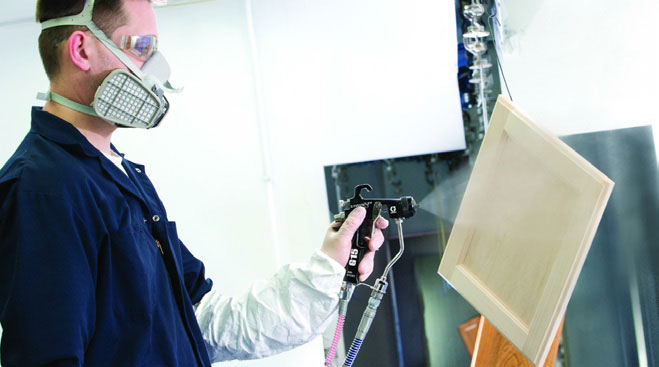Listed below are some of the frequently asked questions for the finishing of solid wood and composite wood products.
Q: How do you mix the catalyst and base with no mistakes?
A: There are mechanical and electronic mixing systems available. By going with these systems, the wastage on mixed products is drastically reduced.
Submitted by EXEL North America Inc./Kremlin
Q: How can I prevent tails and improve spray patterns in airless and air-assist applications?
A: Tails are caused by low fluid pressure and can be solved by increasing the pressure. Material may not be flowing into the pump effectively and may need to be thinned to reduce viscosity. The fluid delivery system also may not be functioning properly and the pump is not being fed material consistently.
Submitted by DeVilbiss, Ransburg, BGK, Binks
 Q: How can I best adjust fluid viscosity to achieve the best quality finish?
Q: How can I best adjust fluid viscosity to achieve the best quality finish?
A: When related to an HVLP turbine spray system we always ask first the size of the system, which would indicate the maximum atomizing pressure. If the finished surface is slightly wavy or orange peeled, we suggest thinning or reducing the coating slightly and then evaluating the results.
Submitted by Apollo Sprayers Intl
Q: Why are transfer efficiency numbers different for the same type of gun?
A: There are two primary test standards when measuring TE. The ASTM test standard simulates a conveyor system. For conventional spraying, ASTM never has a TE greater than 50%. The second type of test, EN13699, is performed by spraying a pattern in the middle of a large target. The EN standard produces higher results due to the way the test is performed.
Submitted by Graco
Q: How can you help me reduce finishing costs?
A: The approach is to not look solely at the finishing materials on a per-gallon or per-liter basis, but with the complete view. In addition, there are other important factors such as recovery/re-use, catalyzed waste and transfer efficiencies that can help lower costs.
Submitted by Sherwin-Willliams






Have something to say? Share your thoughts with us in the comments below.